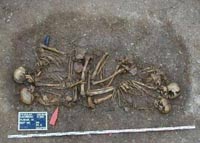|
|

|
|
Human remains are seen in a grave, near Eulau in Germany in this undated handout photograph received in London on November 17, 2008.
|
A 4,600-year-old grave in Germany containing the remains of two adults and their children provides the earliest evidence that even prehistoric tribes attached importance to the family unit, researchers said on Monday.
The researchers used DNA analysis and other techniques to determine that the group buried facing each other -- an unusual practice in Neolithic culture -- consisted of a mother, father and their two sons aged 8-9 and 4-5 years.
"By establishing the genetic links between the two adults and two children buried together in one grave, we have established the presence of the classic nuclear family in a prehistoric context in Central Europe -- to our knowledge the oldest authentic molecular genetic evidence so far," Wolfgang Haak of the University of Adelaide said in a statement.
"Their unity in death suggests a unity in life."
The remains were found in graves that held a total of 13 people, Haak and colleagues reported in the journal Proceedings of the National Academy of Sciences.
Several were buried face-to-face, with arms and hands interlinked in many cases. The remains included children ranging from newborns up to 10 years of age, and adults of around 30 years or older.
Tests showed that many had suffered massive injuries, suggesting they were victims of a violent raid. One female had a stone projectile point embedded in her back and another had skull fractures.
"Our study of the Eulau individuals shows that their deaths were sudden and violent, apparent in lesions caused by stone axes and arrows, with evidence of attempts of some of the individuals to defend themselves from blows," the researchers wrote.
An analysis of dental remains also offered up insight into Stone Age society and showed that the females came from different regions than the males and their children.
This is evidence that men sought partners from different regions to avoid inbreeding and that it was customary for women to move to the location of the males, the researchers said.
"Such traditions would have been important to avoid inbreeding and to forge kinship networks with other communities," Alistair Pike, an archaeologist at the University of Bristol, who co-led the study, said in a statement.
点击查看更多双语新闻
(Agencies)
|
研究人员于本周一称,他们在德国发现了一个距今4600年、葬有两个成年人和两个小孩的墓穴,这是目前发现的最早的可证明史前部落也重视家庭单位的证据。
研究人员采用DNA分析和其它鉴定技术得出结论,墓穴中合葬的是一家四口——包括父亲、母亲和两个年龄分别在8-9岁和4-5岁的男孩。墓中的人是面对面地被埋葬,这在新石器时代并不常见。
阿德莱德大学的沃夫冈·哈克在一份声明中称,通过建立墓穴中四个人的基因联系,我们发现,中欧史前文明时期已存在典型的核心家庭。据我们了解,这是迄今为止发现的最早的可靠分子遗传学证据。
他说:“这种合葬方式说明他们生前也很亲密。”
哈克及其同事在《美国国家科学院院刊》上发表的研究报告中称,这四具遗骸是在几个共葬有13人的墓穴中发现的。
其中有几具遗骸是面对面摆放,有很多遗骸的手臂和手缠在一起。经鉴定,墓穴中的遗骸有刚出生至10岁年龄不等的小孩,还有30多岁的成年人。
鉴定结果显示,很多人死时身负重伤,这表明他们可能死于一场暴力事件。其中一具女性遗骸的背部有一个石弹击中点,还有一具遗骸的头骨有裂痕。
研究人员写道:“通过研究Eulau地区发掘出的这些遗骨,我们可以判断这些人当时死于一场暴力突袭,遗骸上的石斧伤和箭伤可以说明这一点,另外还有一些证据表明有些人死前曾试图保护自己。”
此外,研究人员通过牙齿鉴定发现,墓葬中的女性与她们的丈夫和孩子来自不同的地区,这也增进了人们对石器时代的了解。
研究人员称,这说明当时的男性从不同的地区寻找配偶,以避免近亲繁殖,而女性嫁到男性的家乡也是当时的一大习俗。
研究负责人之一、布里斯托大学考古学家艾利斯戴尔•派克称,这些传统对避免近亲繁殖,以及与其他部落建立血缘关系十分有利。
(实习生许雅宁 英语点津 姗姗 编辑)
|